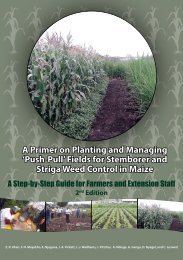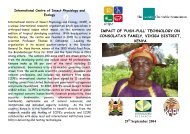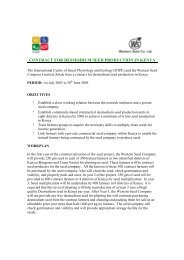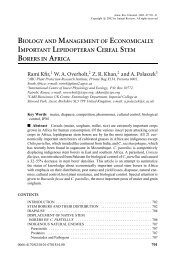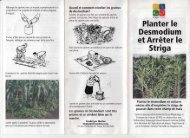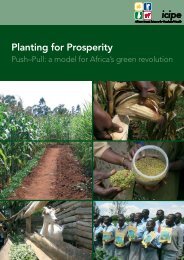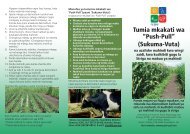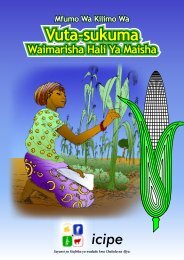The Royal Society Report - Push-Pull
The Royal Society Report - Push-Pull
The Royal Society Report - Push-Pull
Create successful ePaper yourself
Turn your PDF publications into a flip-book with our unique Google optimized e-Paper software.
As diets change, so demand for different types of food will<br />
shift radically, with large numbers of people going through<br />
a ‘nutrition transition’. Increasing urbanisation and growing<br />
prosperity mean that people are more likely to adopt new<br />
diets, particularly consuming more meat, fats and refined<br />
cereals, and fewer traditional cereals, vegetables and fruit<br />
(Fitzhugh 1998; Popkin 1998; Delgado et al. 1999; Smil<br />
2000a). Livestock production has increased dramatically,<br />
with a worldwide 4.4-fold increase in numbers of chickens<br />
since 1961 (to 17 billion), a 2.4-fold increase in pigs (to 9.9<br />
billion), an 0.4–0.5-fold increase in numbers of cattle and<br />
buffalos (to 1.59 billion) and sheep and goats (to<br />
1.96 billion) (see Figure 1.9) (Pretty 2008; FAOSTAT 2009).<br />
Some suggest that demand for livestock products will<br />
double by 2050. Already more than one-third of the world’s<br />
grain is fed to domestic livestock (rising to nearly 70% in<br />
industrialised countries). As incomes rise in developing<br />
countries, so it is expected that demand for meat will tend<br />
towards the per capita consumption rates of 115 kg per<br />
year in the USA and 80 kg per year in the UK. Chinese per<br />
capita annual consumption has already increased from 4 to<br />
54 kg in the past 50 years. On the current trajectory,<br />
livestock production will move further from extensive<br />
(pasture-based grazing) to intensive systems, placing even<br />
more demand on staple grains.<br />
<strong>The</strong> natural environment can be seen as providing a<br />
set of benefits to agriculture (ecosystem services and<br />
organisms for biological control) and constraints (soil,<br />
water, climate, pests and diseases) that determine what<br />
can be grown, where, when and how. <strong>The</strong> primary<br />
constraints on crop production are well understood.<br />
<strong>The</strong>se include biophysical factors such as radiant energy<br />
for photosynthesis (dependent on latitude), temperature<br />
(dependent on latitude and altitude), water, plant nutrients<br />
(primarily nitrogen, phosphorus and potassium), pests<br />
(vertebrates and invertebrates), diseases (bacteria, viruses<br />
and fungi), weeds (other plants) and the availability of<br />
suitable land. <strong>The</strong>se constraints are the subject of Chapter<br />
2 of this report.<br />
<strong>The</strong> effects of climate change on world agriculture are<br />
uncertain. Working Group 2 of the Intergovernmental Panel<br />
on Climate Change (IPCC) has estimated that global crop<br />
production will be threatened by global temperature<br />
increases of 1°C and begin to decline significantly at 3°C<br />
(Easterling et al. 2007). But this global picture flattens out<br />
regional variations that might bring catastrophic impacts<br />
on, for example, the drier tropical areas (Schmidhuber &<br />
Tubiello 2007). <strong>The</strong> social and economic consequences of<br />
environmental change (including changes to biodiversity<br />
and climate) will exacerbate the uncertainties faced by the<br />
world’s poorest billion people.<br />
1.4 <strong>The</strong> need for sustainable intensification<br />
Land used for crop production has grown only slightly<br />
over the period 1961 to 2007 (total agricultural area has<br />
expanded 11% from 4.51 to 4.93 billion ha, and arable area<br />
9% from 1.27 to 1.41 billion ha) (FAOSTAT 2009). Over the<br />
same period the human population grew from 3 to<br />
6.7 billion (an increase of 123%). In industrialised countries,<br />
agricultural area has fallen by 3% over the same period,<br />
but has risen by 21% in developing countries. Half of the<br />
1.4 billion ha of land used for arable crop production<br />
produces grain (approximately 700 million ha). In 1960 the<br />
area used to produce grain was 648 million ha.<br />
Improvements to agricultural production are complicated<br />
by a number of pressures on land availability. As cities<br />
grow, they encroach on rural environments and often on<br />
high quality agricultural land (Montgomery 2007). <strong>The</strong> loss<br />
of soil globally is an increasingly serious problem (Fitter<br />
2005). In many places, land that has previously grown food<br />
is being turned over to biofuels (<strong>Royal</strong> <strong>Society</strong> 2008a). In<br />
some countries use of land for food is prohibited by<br />
Figure 1.9. Head of livestock (1961–2007).<br />
5.0<br />
Head of livestock, world (1961–2007) (FAO, 2009)<br />
4.5<br />
4.0<br />
Ratio (1961 = 1)<br />
3.5<br />
3.0<br />
2.5<br />
2.0<br />
Cattle and buffaloes (1961 = 1.03 bn)<br />
Pigs (1961 = 0.46 bn)<br />
Chickens (1961 = 3.89 bn)<br />
Sheep and goats (1961 = 1.34 bn)<br />
1.5<br />
1.0<br />
0.5<br />
1960 1970 1980 1990 2000 2010<br />
6 I October 2009 I Reaping the Benefits <strong>The</strong> <strong>Royal</strong> <strong>Society</strong>



